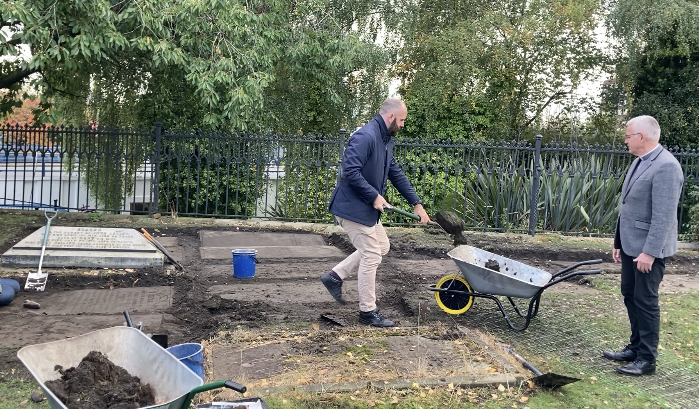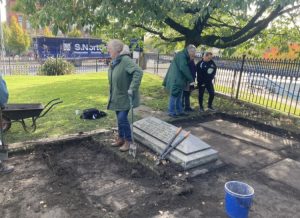
The Mayor of Salford was at St Thomas’ Church, Pendleton, to unofficially open the Uncovering Pendleton’s Past project.
The three week-long project is set out to uncover long-lost gravestones, that have been overgrown with grass. From its opening in 1767, through to the 1970s, St.Thomas’ Church laid gravestones horizontally, over the tomb.
However, when churchgoers in the 1970s decided to cover the stones, in a bid to make the yard look ‘tidier’, years of local history was lost.
Paul Dennett said: “I think unearthing Pendleton’s past speaks to that importance because behind every one of these gravestones including the ones without names on them, there are stories to be told.
“I think the City of Salford and the struggles we’ve had over the years, during the Industrial Revolution, into the 21st Century today are very relevant for trying to inform where we go as a country in the future.”

The Greater Manchester Archaeology Advisory Service (GMAAS) protects and records measures on development sites to keep Greater Manchester’s historic environment alive.
Ian Miller from the GMAAS said: “A pot of funding came available from Historic England, and this seemed like a perfect project to utilise it.
“The church was built as a beacon, almost like a hub for the local community if you like and I think maybe that’s been lost over the last 30 years, so it’s really good to have a project that brings this building and the churchyard back as a focus to the local community.”
Barry Emberton, a member of the Friends of St. Thomas’ Church, highlighted the importance of the project.
He said: “I think it is really essential that the people of Salford understand about their heritage, I think if you think back through time, we have people drawn to Salford and Salford opens its doors to refugees, asylum seekers and people looking for hope for the future.”
After the three weeks ends the digging will be done, however the next six months will be important.
Mr Emberton said: “This is physical work, it’ll last three weeks but in reality, it is only about five percent of what we need to do.
“We will be looking at the inscriptions and going back to all the historical records identifying who they were, family members, where they lived, so we are going to try and create a map that’ll develop from a small court and build outwards over the decades and where people worked, what industries were prevalent and what were their social issues they faced.”














One Comment